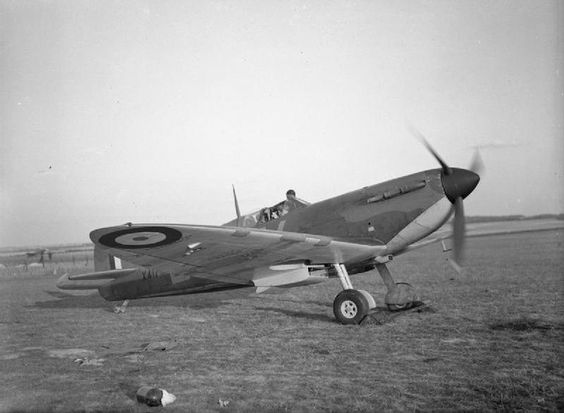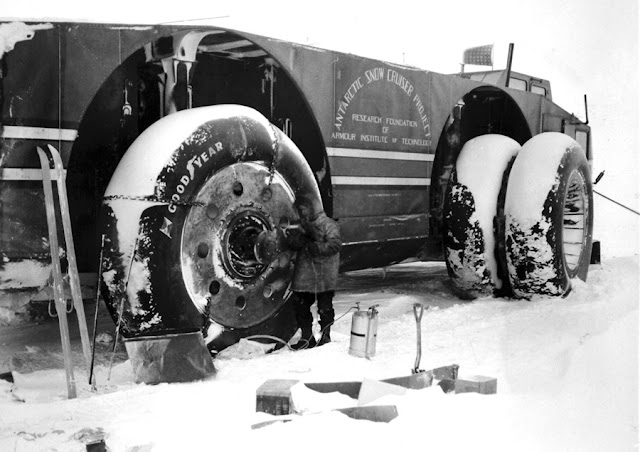Friday 21 November 1941
 |
| General Erwin Romel discusses the situation at Italian headquarters with Italian General Enea Navarini and liaison officer Colonel Diesener on 21 November 1941. Notice that Rommel is seated and the Italian general is standing (Moosmüller, Federal Archive Picture 183-1982-0927-502). |
Eastern Front: The III Panzer Corps, led by the 1st SS Panzer Division "Leibstandarte SS Adolf Hitler" (LSSAH) under Josef "Sepp" Dietrich, captures Rostov-on-Don on 21 November 1941. This is a major feat, achieved by forming a wedge to the southeast against fierce Red Army opposition. Dietrich is Adolf Hitler's former personal bodyguard and an aggressive commander, but he does not have any formal military training. This works in Dietrich's favor in this offensive because it is a very risky endeavor, exposing his forces in three directions to counterattacks that could trap his men far from the main German troop concentrations to the west.
Far to the north, the winter weather finally has frozen Lake Ladoga sufficiently for surface traffic across it. The trip from the nearest Soviet-held town is 40 miles round-trip. Captain Murov's horses and wagons make the first risky trip across carrying flour, sugar, and other foodstuffs in 24 hours. This becomes the "Road of Life."
South of Moscow, General Guderian's attempt to bypass Tula is making a little progress every day, and today shows some small gains. General Karl Weisenberger’s LIII Army Corps takes Uzlovaya, southeast of Tula. This gives Colonel Heinrich Eberbach's dwindling panzers some flank protection. However, it does nothing to help the all-important drive to reach the road to Moscow north of Tula. The Stavka decides that they need someone new in charge of the 50th Army, so the chief of the Red Army General Staff, Marshal Boris Shaposhnikov, appoints Lt. Gen. Ivan Vasilievich Boldin. Boldin sets out for Tula, where he will arrive on the 22nd through the narrow opening north of the city that the Soviets still hold.
Battle of the Mediterranean: The British attempt to relieve Tobruk, Operation Crusader, has led to a wild melee involving the British Eighth Army, Panzer Group Africa, and the garrison of Tobruk. The British still have not reached Tobruk, but they have one more ace to play. British 70th Division launches a three-pronged attack out of the besieged port, with the 2nd Black Watch in the center, the 2nd King's Own on the right, and the 2nd Queen's Own on the left. This takes the Italians who are on garrison duty by surprise, and the Black Watch loses about 200 men and its commanding officer but advances about 3.5 miles (5.6 km) towards Ed Duda. The Italians rally, however, and manage to retain their strongpoint at Tugun. The official New Zealand history recounts:
The day's fighting leaves the Axis forces still in control of their critical defense points, but the outlook is grim due to the British advances. New Zealand troops advance across the Egyptian-Libyan frontier and occupy the vacant Fort Capuzzo. Everything is not rosy for the British, however. The British 7th Armored Brigade has lost 132 of its initial force of 160 tanks due to Italian gunners on the heights surrounding the battlefields. Still, the British are attacking and advancing and the Axis forces are defending and retreating, and that is usually a bad omen in the desert for the forces that are defending and retreating.
November 1941
November 1, 1941: Finns Attack Toward Murmansk Railway
November 2, 1941: Manstein Isolates Sevastopol
November 3, 1941: Japan Prepares to Attack
November 4, 1941: German Advances in the South
November 5, 1941: Last Peace Effort By Japan
November 6, 1941: Stalin Casts Blame in an Unexpected Direction
November 7, 1941: Stalin's Big Parade
November 8, 1941: Germans Take Tikhvin
November 9, 1941: Duisburg Convoy Destruction
November 10, 1941: Manstein Attacks Sevastopol
November 11, 1941: Finland's Double Game Erupts
November 12, 1941: T-34 Tanks Take Charge
November 13, 1941: German Orsha Conference
November 14, 1941: German Supply Network Breaking Down
November 15, 1941: Operation Typhoon Resumes
November 16, 1941: Manstein Captures Kerch
November 17, 1941: Finland Halts Operations
November 18, 1941: British Operation Crusader
November 19, 1941: Sydney vs. Kormoran Duel
November 20, 1941: The US Rejects Final Japanese Demand
November 21, 1941: Germans Take Rostov
November 22, 1941: Kleist in Trouble at Rostov
November 23, 1941: Germans Take Klin, Huge Battle in North Africa
November 24, 1941: Rommel Counterattacks
November 25, 1941: HMS Barham Sunk
November 26, 1941: Japanese Fleet Sails
November 27, 1941: British Relieve Tobruk
November 28, 1941: Rostov Evacuated, German Closest Approach to Moscow
November 29, 1941: Hitler Furious About Retreat
November 30, 1941: Japan Sets the Date for its Attack
2020
 |
| General Erwin Rommel arrives at the headquarters of the Italian Army Corps that is manning the line around Tobruk, 21 November 1941 (Moosmülle, Federal Archive Bild 183-R95988). |
 |
| General Udet's casket is brought in to the Reich Ministry of Aviation in the presence of Reichmarschall Hermann Goering (left) and Adolf Hitler (on the overlooking portico) on 21 November 1941. Adolf Galland leads the procession to the casket's left. All of the pallbearers are holders of the Knight's Cross. Udet's suicide has been described as being the result of an accident to the Reich press (Federal Archive Picture 146-1981-066-11A). |
 |
| "Prime Minister Winston Churchill poses outside 10 Downing Street, London, England, wearing a 'Thumbs up' badge on 21 November 1941" © IWM (H 15674). |
The more elaborate attack on Tugun went in at 1500 hours and gained perhaps half the position, together with 250 Italians and many light field guns. But the Italians in the western half could not be dislodged and the base of the break-out area remained on this account uncomfortably narrow... [The] strong Italian opposition at Tugun was part of the reason for the decision to halt the sortie at this time.Another fierce battle develops around Sidi Rezegh that leads to heavy casualties by both sides but little change in positions.
 |
| Recruits of the Singapore Volunteer Force training with a Lewis gun, November 1941. |
Have been informed by Dutch Legation that they have received a dispatch as follows:
“According to information received by the Governor General of The Netherlands East Indies a Japanese expeditionary force has arrived in the vicinity of Palau. Should this force, strong enough to form a threat for The Netherlands Indies or Portuguese Timor, move beyond a line between the following points Davao (Philippine Islands) Waigeo (Island, Netherlands East Indies) Equator the Governor General will regard this as an act of aggression and will under those circumstances consider the hostilities opened and act accordingly."
Inform Army authorities of foregoing. Request any information you may have concerning development of this Japanese threat against the Dutch East Indies and your evaluation of foregoing information.Thus, events are rapidly approaching a crisis point in the Pacific. The real question is not whether hostilities will commence, but when and where. The Dutch have strong naval forces present and a willingness to use them, and it is quite possible that the Pacific flashpoint could have nothing to do with United States forces.
November 1941
November 1, 1941: Finns Attack Toward Murmansk Railway
November 2, 1941: Manstein Isolates Sevastopol
November 3, 1941: Japan Prepares to Attack
November 4, 1941: German Advances in the South
November 5, 1941: Last Peace Effort By Japan
November 6, 1941: Stalin Casts Blame in an Unexpected Direction
November 7, 1941: Stalin's Big Parade
November 8, 1941: Germans Take Tikhvin
November 9, 1941: Duisburg Convoy Destruction
November 10, 1941: Manstein Attacks Sevastopol
November 11, 1941: Finland's Double Game Erupts
November 12, 1941: T-34 Tanks Take Charge
November 13, 1941: German Orsha Conference
November 14, 1941: German Supply Network Breaking Down
November 15, 1941: Operation Typhoon Resumes
November 16, 1941: Manstein Captures Kerch
November 17, 1941: Finland Halts Operations
November 18, 1941: British Operation Crusader
November 19, 1941: Sydney vs. Kormoran Duel
November 20, 1941: The US Rejects Final Japanese Demand
November 21, 1941: Germans Take Rostov
November 22, 1941: Kleist in Trouble at Rostov
November 23, 1941: Germans Take Klin, Huge Battle in North Africa
November 24, 1941: Rommel Counterattacks
November 25, 1941: HMS Barham Sunk
November 26, 1941: Japanese Fleet Sails
November 27, 1941: British Relieve Tobruk
November 28, 1941: Rostov Evacuated, German Closest Approach to Moscow
November 29, 1941: Hitler Furious About Retreat
November 30, 1941: Japan Sets the Date for its Attack
2020













